-
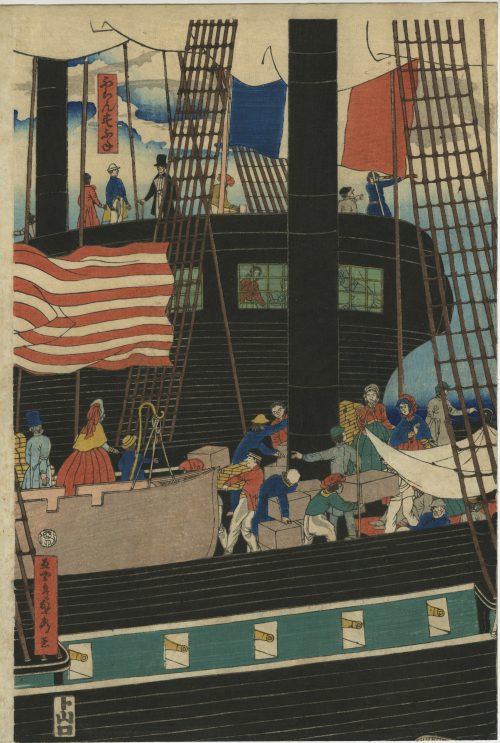 Utagawa Sadahide, a.k.a. Gountei Sadahide (Japanese, 1807 – c. 1878–1879), 五雲亭 貞秀, 歌川 貞秀, Yamaguchiya Tōbei, Yokohama kōeki seiyōjin nimotsu unsō no zu - Western traders loading cargo in Yokohama - 横浜交易西洋人荷物運送之圖, 1861, Woodblock print (nishiki-e); ink and color on paper, Horizontal Ōban Pentaptych: 5 x (37 x 25.5 cm), Alternative title: Picture of Western Traders at Yokohama Transporting Merchandise (Cat. Reisonée: Yokohama ukiyo-e, Yurindo, 1979: №50). Japanese pentaptych print shows an American ship in the harbor at Yokohama, Japan; small boats ferry cargo which is being carried up a gangplank contributing to the bustle of activity on the main deck. April, 1861. SOLD
Utagawa Sadahide, a.k.a. Gountei Sadahide (Japanese, 1807 – c. 1878–1879), 五雲亭 貞秀, 歌川 貞秀, Yamaguchiya Tōbei, Yokohama kōeki seiyōjin nimotsu unsō no zu - Western traders loading cargo in Yokohama - 横浜交易西洋人荷物運送之圖, 1861, Woodblock print (nishiki-e); ink and color on paper, Horizontal Ōban Pentaptych: 5 x (37 x 25.5 cm), Alternative title: Picture of Western Traders at Yokohama Transporting Merchandise (Cat. Reisonée: Yokohama ukiyo-e, Yurindo, 1979: №50). Japanese pentaptych print shows an American ship in the harbor at Yokohama, Japan; small boats ferry cargo which is being carried up a gangplank contributing to the bustle of activity on the main deck. April, 1861. SOLD -

Каторга и ссылка. Историко-революционный вестник. Книга 9, № 2, 1924. Общество бывших политических каторжан и ссылно-поселенцев. Под общей редакцией Вл. Виленского (Сибирякова). Москва, 1924. Государственное издательство "Типография Печатный Двор", Ленинград. Тираж: 4,000 экз. Две гравюры на дереве А.И.Кравченко "В дни скорби. Похороны В.И. Ленина на Красной площади" и "В.И.Ленин в Доме Союзов. 23-27 января 1924 г."
-
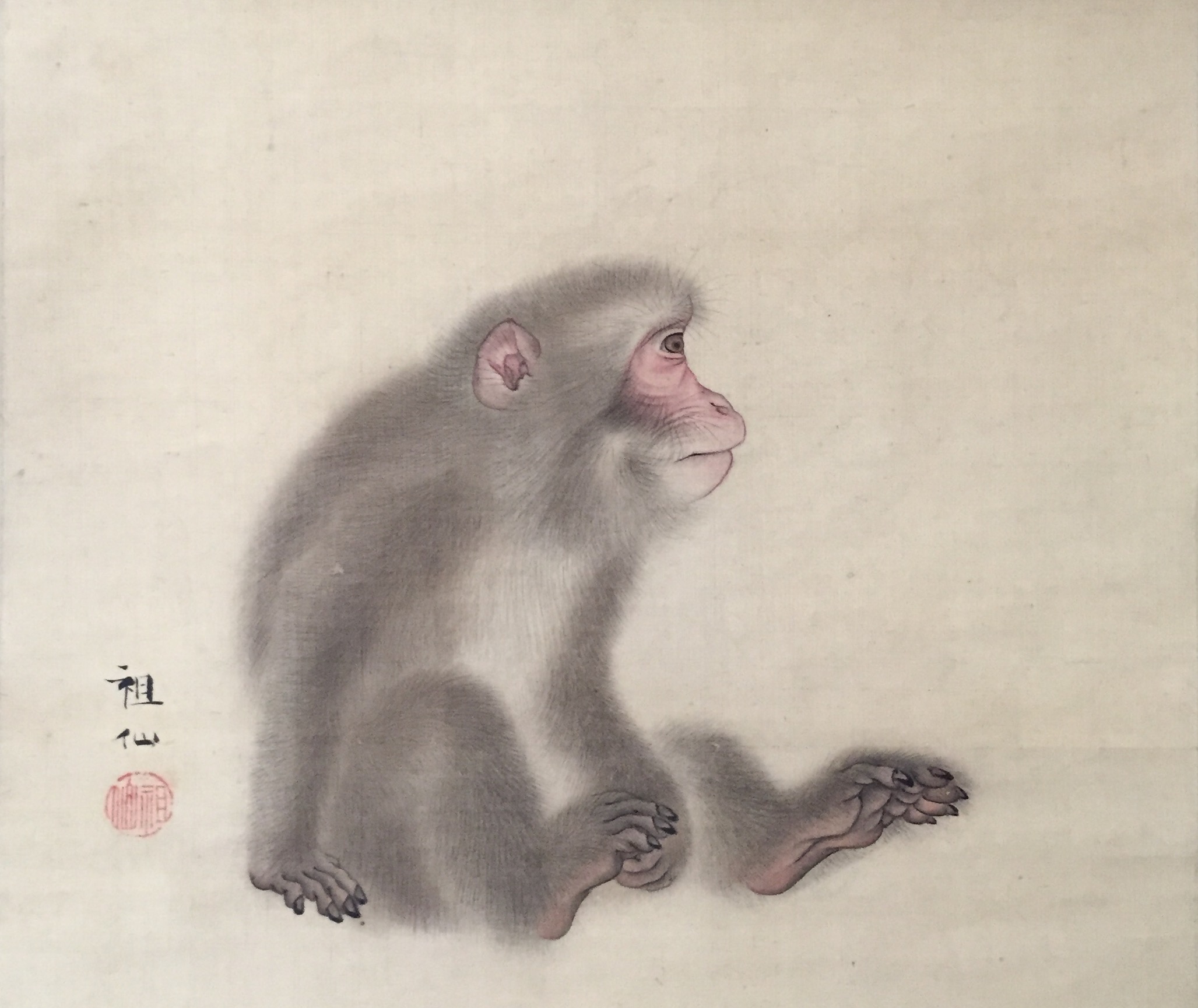 Mori Sosen (1747-1821). Seated Monkey. Hanging scroll painting. Ink and colour on silk. Signed: Sosen. Sealed: Sosen. 28.8 x 33.3 cm.
Mori Sosen (1747-1821). Seated Monkey. Hanging scroll painting. Ink and colour on silk. Signed: Sosen. Sealed: Sosen. 28.8 x 33.3 cm. -
 Iron tsuba of oval form with design of stylized paulownia (nage-giri) in openwork (sukashi). Leaf veins carved in kebori technique. Rounded rim. Copper sekigane. Unsigned. Attributed to Kanshirō, third generation Nishigaki (1680-1761). Edo period: Early 18th century (Kyoho / Genbun era). Size: Height: 77.8 mm. Width: 71.9 mm. Rim thickness: 5.9 mm. Center thickness: 5.0 mm. Provenance: Sasano Masayuki Collection, № 264: "Nishigaki. Third generation Kanshiro (died in in the eleventh year of Hohreki, 1761 at the age of eighty-two). This oblong shape appears a little amateurish at first, however, it was done intentionally to add flavor to to the design. The neat composition is a feature of the third Kanshiro."
Iron tsuba of oval form with design of stylized paulownia (nage-giri) in openwork (sukashi). Leaf veins carved in kebori technique. Rounded rim. Copper sekigane. Unsigned. Attributed to Kanshirō, third generation Nishigaki (1680-1761). Edo period: Early 18th century (Kyoho / Genbun era). Size: Height: 77.8 mm. Width: 71.9 mm. Rim thickness: 5.9 mm. Center thickness: 5.0 mm. Provenance: Sasano Masayuki Collection, № 264: "Nishigaki. Third generation Kanshiro (died in in the eleventh year of Hohreki, 1761 at the age of eighty-two). This oblong shape appears a little amateurish at first, however, it was done intentionally to add flavor to to the design. The neat composition is a feature of the third Kanshiro." -
 Mokkō form iron tsuba carved in relief and inlaid with soft metals (copper, gold, silver) with the design of a cormorant fisherman on the face and a boat on the reverse. Unsigned. Dimensions: 77 mm x 69 mm x 3.0 mm (at seppa-dai) Edo period: 18th or 19th century. "Since Nara period, Japanese fishermen in small boats have used cormorants (u) to catch river fish at night, binding the necks of the birds so that the fish are not swallowed. [...] The bird and the work it performs are symbols of selfless devotion to one's master and keen eyesight." - from Merrily Baird. Symbols of Japan. Thematic motifs in art and design. Rizzoli international publications, Inc., 2001; p. 104. See also in this collection TSU-0212 and TSU-0241.
Mokkō form iron tsuba carved in relief and inlaid with soft metals (copper, gold, silver) with the design of a cormorant fisherman on the face and a boat on the reverse. Unsigned. Dimensions: 77 mm x 69 mm x 3.0 mm (at seppa-dai) Edo period: 18th or 19th century. "Since Nara period, Japanese fishermen in small boats have used cormorants (u) to catch river fish at night, binding the necks of the birds so that the fish are not swallowed. [...] The bird and the work it performs are symbols of selfless devotion to one's master and keen eyesight." - from Merrily Baird. Symbols of Japan. Thematic motifs in art and design. Rizzoli international publications, Inc., 2001; p. 104. See also in this collection TSU-0212 and TSU-0241. -
 Kitagawa Utamaro. Illustration from book Ehon koi no Onamaki, published in 1799. Reference found by Chris Uhlenbeck: he found one of the designs in Hayashi Yoshikazu's 20-volume set Edo makura-e shi shusei: Kitagawa Utamaro. Size: Chuban (25.5 x 18.5 cm), two book pages glued together.
Kitagawa Utamaro. Illustration from book Ehon koi no Onamaki, published in 1799. Reference found by Chris Uhlenbeck: he found one of the designs in Hayashi Yoshikazu's 20-volume set Edo makura-e shi shusei: Kitagawa Utamaro. Size: Chuban (25.5 x 18.5 cm), two book pages glued together. -
 This tsuba is a cut from a typical Bizen Shōami butterfly tsuba (see TSU-0100 in this collection), which normally would have had a circular rim around the butterfly. In this particular example of altered guard we have both eyes of the insect (inlaid in brass or copper) intact. The kebori carving is more pronounced than in TSU-0100 example. Copper sekigane. Unsigned. Attributed to Bizen Shōami school, early Edo period (17th century). Dimensions: 64.7 x 63.7 x 5.2 mm References: see TSU-0100.
This tsuba is a cut from a typical Bizen Shōami butterfly tsuba (see TSU-0100 in this collection), which normally would have had a circular rim around the butterfly. In this particular example of altered guard we have both eyes of the insect (inlaid in brass or copper) intact. The kebori carving is more pronounced than in TSU-0100 example. Copper sekigane. Unsigned. Attributed to Bizen Shōami school, early Edo period (17th century). Dimensions: 64.7 x 63.7 x 5.2 mm References: see TSU-0100. -
 A pair of copper menuki in the form of a shrimp (lobster, crawfish, ebi) with eyes inlaid in shakudō.
A pair of copper menuki in the form of a shrimp (lobster, crawfish, ebi) with eyes inlaid in shakudō.Length: 58.2 mm.
-
 Katsukawa Shunshō ( 勝川 春章; 1726 – 19 January 1793).
Katsukawa Shunshō ( 勝川 春章; 1726 – 19 January 1793).Signed: Shunchô ga (春潮画); Censor's seal: kiwame (改印:極)
Publisher: Iwatoya Kisaburō (Eirindō); c. 1760s – 1832. Marks #173/p.169.
Reference: MFA ACCESSION NUMBER 11.21263. Not in Pins.
Act VII, Gion Ichiriki no ba ("The Ichiriki Teahouse at Gion") This act gives a taste of the bustling atmosphere of the Gion pleasure quarter in Kyoto. Yuranosuke is feigning a life of debauchery at the same teahouse to which Okaru has been indentured. Kudayū, the father of Sadakurō, arrives. He is now working for Moronō and his purpose is to discover whether Yuranosuke still plans revenge or not. He tests Yuranosuke's resolve by offering him food on the anniversary of their lord's death when he should be fasting. Yuranosuke is forced to accept. Yuranosuke's sword – the revered symbol of a samurai – is also found to be covered in rust. It would appear that Yuranosuke has no thoughts of revenge. But still unsure, Kudayū hides under the veranda. Now believing himself alone, Yuranosuke begins to read a secret letter scroll about preparations for the vendetta. On a higher balcony Okaru comes out to cool herself in the evening breeze and, noticing Yuranosuke close by, she also reads the letter reflected in her mirror. As Yuranosuke unrolls the scroll, Kudayū, too, examines the end which trails below the veranda. Suddenly, one of Okaru's hairpins drops to the floor and a shocked Yuranosuke quickly rolls up the scroll. Finding the end of the letter torn off, he realises that yet another person knows his secret and he must silence them both. Feigning merriment, he calls Okaru to come down and offers to buy out her contract. He goes off supposedly to fix the deal. Then Okaru's brother Heiemon enters and, hearing what has just happened, realises that Yuranosuke actually intends to keep her quiet by killing her. He persuades Okaru to let him kill her instead so as to save their honour and she agrees. Overhearing everything, Yuranosuke is now convinced of the pair's loyalty and stops them. He gives Okaru a sword and, guiding her hand, thrusts it through the floorboards to kill Kudayū. The main actor has to convey a wide variety of emotions between a fallen, drunkard rōnin and someone who in reality is quite different since he is only faking his weakness. This is called hara-gei or "belly acting", which means he has to perform from within to change characters. It is technically difficult to perform and takes a long time to learn, but once mastered the audience takes up on the actor's emotion. Emotions are also expressed through the colours of the costumes, a key element in kabuki. Gaudy and strong colours can convey foolish or joyful emotions, whereas severe or muted colours convey seriousness and focus. -
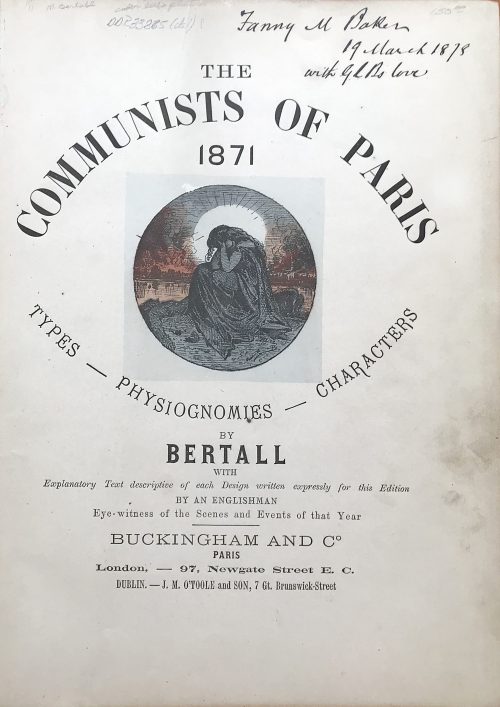 Folio (246 x 321 mm), hardbound in red-brown cloth with gilt lettering and decoration. Content, Introduction by J. E., September, 1873, Artist preface by Bertall, Paris, 1871-1873. Album with 40 hand-colored lithographs by Bertall, numbered 1 through 40, accompanied with extensive descriptions. Ex Libris: Baker. Carpe Diem. Markings: Janny M. Baker with J.L.B. Love, 19 March, 1878 in black ink.
Folio (246 x 321 mm), hardbound in red-brown cloth with gilt lettering and decoration. Content, Introduction by J. E., September, 1873, Artist preface by Bertall, Paris, 1871-1873. Album with 40 hand-colored lithographs by Bertall, numbered 1 through 40, accompanied with extensive descriptions. Ex Libris: Baker. Carpe Diem. Markings: Janny M. Baker with J.L.B. Love, 19 March, 1878 in black ink. -

Yamagane (bronze) tsuba (kagamishi, or mirror-maker) with the design of tomoe (comma) and suhama in openwork. Surface treated with hammer marks and chiselled with the design of maple leaves and encircled two bars (maru-ni-futatsu-biki, Ashikaga clan family crest, or mon) on both sides. Raised rim or rim cover (fukurin). Custom kiri-wood box.
Size: 87.4 x 86.2 x 2.9 (center), 4.9 (rim) mm; weight: 120 g. -
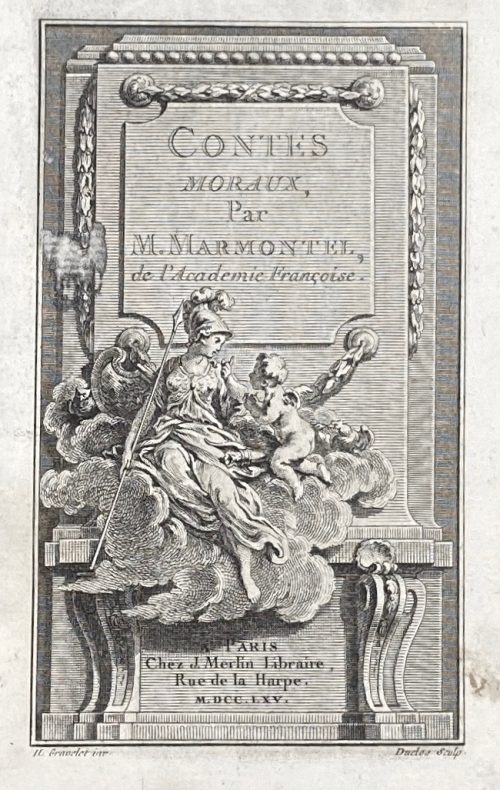 Engraved title-page: Contes | Moraux | Par | M. Marmontel, | de l'Academie Françoise. | A Paris | Chez J. Merlin Libraire, | Rue de la Harpe, | M DCC LXV ||Description: 3 volumes, 8vo, 20.4 x 13 cm, first issue, bound in the contemporary speckled calf, all edges gilt, spines gilt with double red/brown lettering labels (vol 1. labels missing); raised bands, gilt in compartments, double gilt-ruled borders; marbled endpapers. With the contemporary signature in each volume of Caroline Marlborough of Blenheim Palace, and bookplates of Lord F. A. Spencer. This is certainly Lady Caroline Russell, wife of George Spencer, Fourth Duke of Marlborough; she was daughter to the Duke of Bedford and was married in 1762. She died at Blenheim in 1811. The later bookplate in each volume pasted to the front pastedown of her son Francis Almeric Spencer (British, 1779-1845). Pagination: Vol. I: [two blank leaves] [half-title, verso blank] [recto blank, frontispiece on verso: portrait of Marmontel by St. Aubin after Cochin] [engraved t.p. by Duclos after Gravelot, verso blank], [i] ii-xvi, [table des contes with 5-line Errata (autograph Lordine Marlborough), verso blank], [1] 2–345 [346-50 blanks]; 9 plates after Gravelot by: Baquoy, de Longueil (2), Legrand, Leveau (2), Rousseau, Voyez, and unsigned (1). Vol. 2: [two blank leaves] [half-title, verso blank] [engraved t.p. by Duclos after Gravelot, verso blank] [table des contes with 10-line Errata (autograph Lordine Marlborough), verso blank], [1] 2–376 [377-50 blanks]; 9 plates after Gravelot by: de Longueil (5), Leveau (2), Pasquier and Rousseau. Vol. 3: [two blank leaves] [half-title, verso blank] [engraved t.p. by Duclos after Gravelot, verso blank] [table des contes with 9-line Errata, verso blank] [two leaves: approbation and Privilege du Roi] [1] 2–312 [313-16 blanks]; 5 plates after Gravelot by: de Longueil (2), Le Mire (2), and Pasquier. Catalogue raisonné: Cohen-De Ricci 686-7; Gordon N. Ray. The Art of the French Illustrated Book 1700 to 1914. — NY, London: The Pierpont Morgan Library; Cornell University Press, 1982, Vol. 1. pp. 44-5. [In their copy vol. 2 and 3 in a different order]; MFA ACCESSION NUMBER 37.1488a-c Illustrated by: Hubert François Gravelot (French, 1699–1773) Engraved by: Jean Charles Baquoy (French, 1721–1777) Engraved by: Antoine Jean Duclos (French, 1742–1795) Engraved by: Louis Legrand (French, 1723–1807) Engraved by: Noël Le Mire (French, 1724–1801) Engraved by: Jean Jacques André Le Veau (French, 1729–1785) Engraved by: Joseph de Longueil (French, 1730–1792) Engraved by: Jean Jacques Pasquier (French, died in 1785) Engraved by: Jean François Rousseau (French, born in 1740) Engraved by: Nicolas Joseph Voyez l'ainé (French, 1742–1806) Portrait(s) designed by: Charles-Nicolas Cochin le fils (French, 1715–1790) Engraved by: Augustin de Saint-Aubin (French, 1736–1807) Author: Jean-François Marmontel (French, 1723–1799) Publisher: Joseph Merlin (French, 1718–1783) Printer: Pierre-Alexandre Le Prieur (French, born in 1722)
Engraved title-page: Contes | Moraux | Par | M. Marmontel, | de l'Academie Françoise. | A Paris | Chez J. Merlin Libraire, | Rue de la Harpe, | M DCC LXV ||Description: 3 volumes, 8vo, 20.4 x 13 cm, first issue, bound in the contemporary speckled calf, all edges gilt, spines gilt with double red/brown lettering labels (vol 1. labels missing); raised bands, gilt in compartments, double gilt-ruled borders; marbled endpapers. With the contemporary signature in each volume of Caroline Marlborough of Blenheim Palace, and bookplates of Lord F. A. Spencer. This is certainly Lady Caroline Russell, wife of George Spencer, Fourth Duke of Marlborough; she was daughter to the Duke of Bedford and was married in 1762. She died at Blenheim in 1811. The later bookplate in each volume pasted to the front pastedown of her son Francis Almeric Spencer (British, 1779-1845). Pagination: Vol. I: [two blank leaves] [half-title, verso blank] [recto blank, frontispiece on verso: portrait of Marmontel by St. Aubin after Cochin] [engraved t.p. by Duclos after Gravelot, verso blank], [i] ii-xvi, [table des contes with 5-line Errata (autograph Lordine Marlborough), verso blank], [1] 2–345 [346-50 blanks]; 9 plates after Gravelot by: Baquoy, de Longueil (2), Legrand, Leveau (2), Rousseau, Voyez, and unsigned (1). Vol. 2: [two blank leaves] [half-title, verso blank] [engraved t.p. by Duclos after Gravelot, verso blank] [table des contes with 10-line Errata (autograph Lordine Marlborough), verso blank], [1] 2–376 [377-50 blanks]; 9 plates after Gravelot by: de Longueil (5), Leveau (2), Pasquier and Rousseau. Vol. 3: [two blank leaves] [half-title, verso blank] [engraved t.p. by Duclos after Gravelot, verso blank] [table des contes with 9-line Errata, verso blank] [two leaves: approbation and Privilege du Roi] [1] 2–312 [313-16 blanks]; 5 plates after Gravelot by: de Longueil (2), Le Mire (2), and Pasquier. Catalogue raisonné: Cohen-De Ricci 686-7; Gordon N. Ray. The Art of the French Illustrated Book 1700 to 1914. — NY, London: The Pierpont Morgan Library; Cornell University Press, 1982, Vol. 1. pp. 44-5. [In their copy vol. 2 and 3 in a different order]; MFA ACCESSION NUMBER 37.1488a-c Illustrated by: Hubert François Gravelot (French, 1699–1773) Engraved by: Jean Charles Baquoy (French, 1721–1777) Engraved by: Antoine Jean Duclos (French, 1742–1795) Engraved by: Louis Legrand (French, 1723–1807) Engraved by: Noël Le Mire (French, 1724–1801) Engraved by: Jean Jacques André Le Veau (French, 1729–1785) Engraved by: Joseph de Longueil (French, 1730–1792) Engraved by: Jean Jacques Pasquier (French, died in 1785) Engraved by: Jean François Rousseau (French, born in 1740) Engraved by: Nicolas Joseph Voyez l'ainé (French, 1742–1806) Portrait(s) designed by: Charles-Nicolas Cochin le fils (French, 1715–1790) Engraved by: Augustin de Saint-Aubin (French, 1736–1807) Author: Jean-François Marmontel (French, 1723–1799) Publisher: Joseph Merlin (French, 1718–1783) Printer: Pierre-Alexandre Le Prieur (French, born in 1722) -
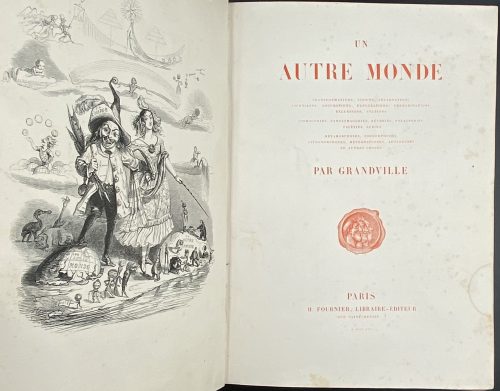 Description: One volume, collated 4t0, 27.3 x 20 cm, bound in contemporary quarter black chagrin, gilt ornaments and lettering to spine (reliure à l'époque romantique), marbled end-papers; printed on wove paper (vélin fort). Title-page (red): UN | AUTRE MONDE | TRANSFORMATIONS, VISIONS, INCARNATIONS | ASCENSIONS, LOCOMOTIONS, EXPLORATIONS, PÉRÉGRINATIONS | EXCURSIONS, STATIONS || COSMOGONIES, FANTASMAGORIES, RÈVERIES, FOLATRERIES | FACÉCIES, LUBIES || MÉTAMORPHOSES, ZOOMORPHOSES | LITHOMORPHOSES, MÉTEMPSYCHOSES, APOTHÉOSES | ET AUTRES CHOSES | PAR GRANDVILLE | [device] | PARIS | H. FOURNIER, LIBRAIRE-ÉDITEUR | RUE SAINT-BENOIT, 7 | M DCCC XLIV Pagination: ff, [2] half-title in red / imprim., [2] blank / frontis. in black, [2] title page in red / blank, [1] 2-295, [1] explication and erratum, bf, illustrations. Collation: 4to, (1)-(37)4 with frontispiece, 133 woodcut vignettes, 15 full-page black woodcuts, and 36 hand-coloured plates. Catalogue raisonné: Carteret (p. 285) describes the book as 'in-8', but the collation is actually in quarto (in-4, or 4to) with series signed in Arabic numerals. Ray (French): p. 275-7. The publication is anonymous, however, Grandville reveals the author's name (that's Taxile Delord) on the vignette on p. 292 at the bottom of the plate (under ICI).
Description: One volume, collated 4t0, 27.3 x 20 cm, bound in contemporary quarter black chagrin, gilt ornaments and lettering to spine (reliure à l'époque romantique), marbled end-papers; printed on wove paper (vélin fort). Title-page (red): UN | AUTRE MONDE | TRANSFORMATIONS, VISIONS, INCARNATIONS | ASCENSIONS, LOCOMOTIONS, EXPLORATIONS, PÉRÉGRINATIONS | EXCURSIONS, STATIONS || COSMOGONIES, FANTASMAGORIES, RÈVERIES, FOLATRERIES | FACÉCIES, LUBIES || MÉTAMORPHOSES, ZOOMORPHOSES | LITHOMORPHOSES, MÉTEMPSYCHOSES, APOTHÉOSES | ET AUTRES CHOSES | PAR GRANDVILLE | [device] | PARIS | H. FOURNIER, LIBRAIRE-ÉDITEUR | RUE SAINT-BENOIT, 7 | M DCCC XLIV Pagination: ff, [2] half-title in red / imprim., [2] blank / frontis. in black, [2] title page in red / blank, [1] 2-295, [1] explication and erratum, bf, illustrations. Collation: 4to, (1)-(37)4 with frontispiece, 133 woodcut vignettes, 15 full-page black woodcuts, and 36 hand-coloured plates. Catalogue raisonné: Carteret (p. 285) describes the book as 'in-8', but the collation is actually in quarto (in-4, or 4to) with series signed in Arabic numerals. Ray (French): p. 275-7. The publication is anonymous, however, Grandville reveals the author's name (that's Taxile Delord) on the vignette on p. 292 at the bottom of the plate (under ICI).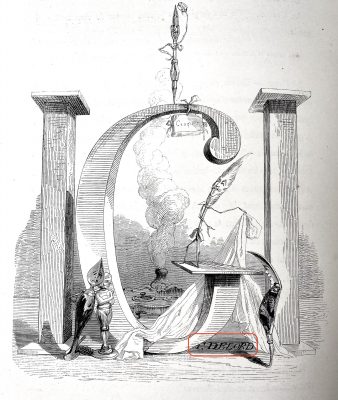
-
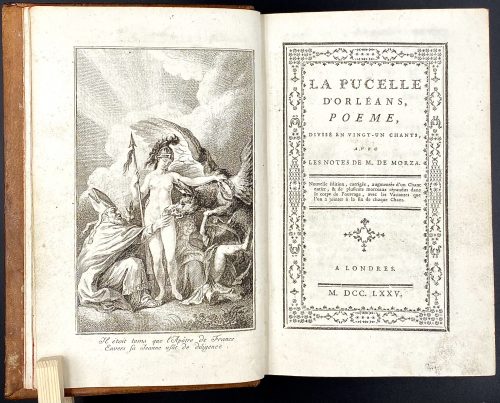 Half title: LA PUCELLE | D’ORLEANS.|| Title: LA PUCELLE | D’ORLEANS , | POEME , | DIVISÉ EN VINGT-UN CHANTS , AVEC | LES NOTES DE M. DE MORZA. | Nouvelle édition, corrigée, augmentée d'un Chant | entier, & de plusieurs morceaux répandus dans | le corps de l'ouvrage, avec les Variantes que | l'on a jointes à la fin de chaque Chant. | [ornament] | A LONDRES. |—| M. DCC. LXXV. || Pagination : [4] – two blank unnumbered fly leaves, [i,ii] – h.t. / double-ruled blank leaf, [2] – blank / frontispiece on verso, [iii, iv] – t.p. ruled and bordered / double-ruled blank leaf, [v]vi-viii – table, ix-xv – preface, [xvi] – double-ruled blank leaf, [1]2-447 [448] – double-ruled blank leaf, [2] – two blank unnumbered fly leaves; page 14 misnumbered 18; title within ornamental border; text within double-ruled borders; head- and tail-pieces; 22 leaves of plates (frontis. + one before each chant.) Collation: 8vo; a8 A-Z8 Aa-Ee8 Binding: 19.9 x 13.2 cm; full contemporary brown calf, blind ruled plates, spine with raised bands, gilt-ruled and tooled in compartments, red label with gilt lettering, all edges red; plate for chant 6, H4, H5 - separated from the block. De Morza is Voltaire (Cf. Quérard, v. 10, p. 306). Engravings unsigned; attributed to Desrais, Claude-Louis (French, 1746 – 1816). False imprint; possibly printed in Paris.
Half title: LA PUCELLE | D’ORLEANS.|| Title: LA PUCELLE | D’ORLEANS , | POEME , | DIVISÉ EN VINGT-UN CHANTS , AVEC | LES NOTES DE M. DE MORZA. | Nouvelle édition, corrigée, augmentée d'un Chant | entier, & de plusieurs morceaux répandus dans | le corps de l'ouvrage, avec les Variantes que | l'on a jointes à la fin de chaque Chant. | [ornament] | A LONDRES. |—| M. DCC. LXXV. || Pagination : [4] – two blank unnumbered fly leaves, [i,ii] – h.t. / double-ruled blank leaf, [2] – blank / frontispiece on verso, [iii, iv] – t.p. ruled and bordered / double-ruled blank leaf, [v]vi-viii – table, ix-xv – preface, [xvi] – double-ruled blank leaf, [1]2-447 [448] – double-ruled blank leaf, [2] – two blank unnumbered fly leaves; page 14 misnumbered 18; title within ornamental border; text within double-ruled borders; head- and tail-pieces; 22 leaves of plates (frontis. + one before each chant.) Collation: 8vo; a8 A-Z8 Aa-Ee8 Binding: 19.9 x 13.2 cm; full contemporary brown calf, blind ruled plates, spine with raised bands, gilt-ruled and tooled in compartments, red label with gilt lettering, all edges red; plate for chant 6, H4, H5 - separated from the block. De Morza is Voltaire (Cf. Quérard, v. 10, p. 306). Engravings unsigned; attributed to Desrais, Claude-Louis (French, 1746 – 1816). False imprint; possibly printed in Paris. -
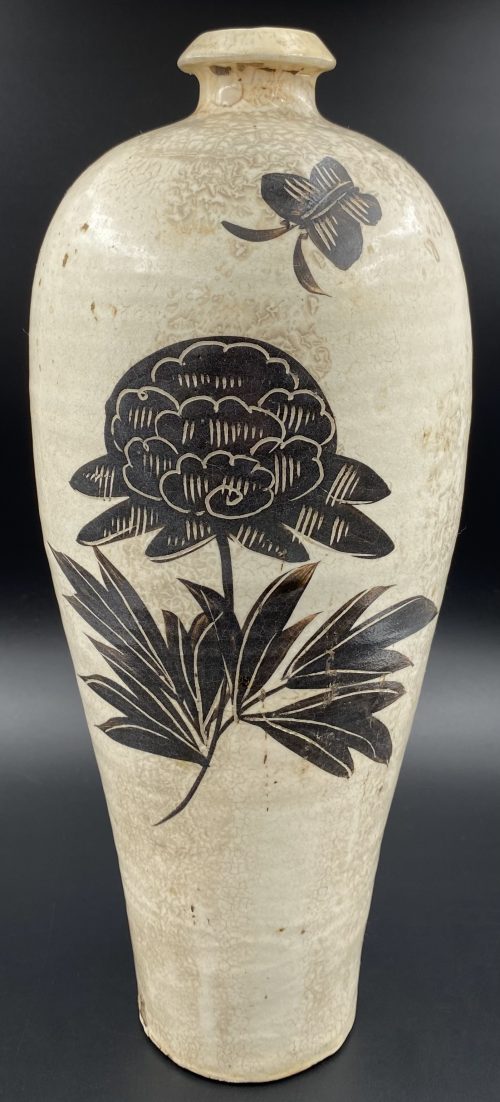 Typical meiping body, short neck, lipped rim; painted in the blackish-brown slip with two blossoms and butterflies under a clear glaze. The foot ring is unglazed exposing the brown body. China, the Yuan Dynasty [大元] (1279 – 1368). Diameter: 14 cm; Height: 30.5 cm.
Typical meiping body, short neck, lipped rim; painted in the blackish-brown slip with two blossoms and butterflies under a clear glaze. The foot ring is unglazed exposing the brown body. China, the Yuan Dynasty [大元] (1279 – 1368). Diameter: 14 cm; Height: 30.5 cm. -
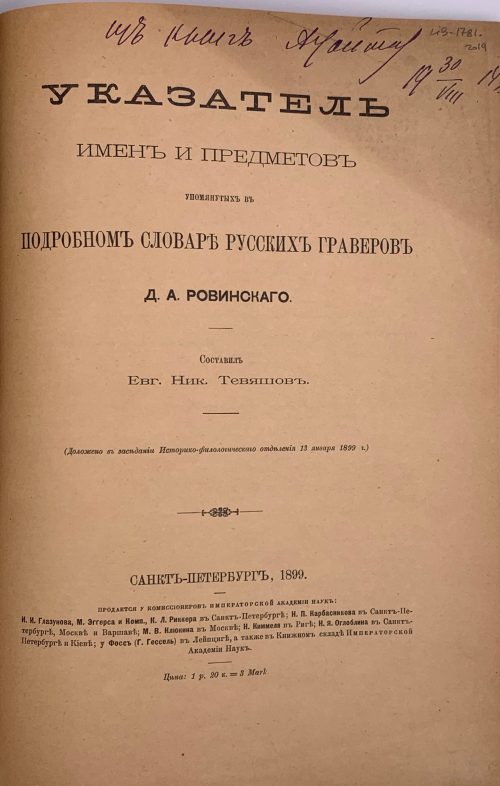 УКАЗАТЕЛЬ | ИМЕНЪ И ПРЕДМЕТОВЪ | УПОМЯНУТЫХЪ ВЪ | ПОДРОБНОМЪ СЛОВАРЕѢ РУССКИХЪ ГРАВЕРОВЪ Д. А. РОВИНСКАГО. | СОСТАВИЛЪ | ЕВГ. НИК. ТЕВЯШОВЪ. | (Доложено въ заседанiи Историко-филологическаго отделенiя 13 января 1899 г.) | САНКТЪ-ПЕТЕРБУРГЪ, 1899. | ПРОДАЕТСЯ У КОМИССIОНЕРОВЪ ИМПЕРАТОРСКОЙ АКАДЕМИИ НАУКЪ: | И. И. Глазунова, М. Эггерса и Комп., К. Л. Риккера въ Санктъ-Петербургѣ; Н. П. Карбасникова въ Санктъ-Пе- | тербургѣ, Москвѣ и Варшавѣ; | М. В. Клюкина въ Москве; Н. Киммеля въ Ригѣ; Н. Я. Оглоблина въ Санктъ- | Петербургѣ и Кiевѣ; у Фоссъ (Г. Гэссель) въ Лейпцигѣ, а также въ Книжномъ складѣ Императорской | академiи наукъ. | Цена: 1 р. 20 к. = 3 Mark. Pagination: original wrapper bound in, [2] t.p. / colophon, [1, 2] 3-208 (numbered half-pages, 52 leaves). Collation: 4to; 1-134. Binding: Owner's later 3/4 grey cloth over buckram boards. original front wrapper preserved, upper-right corner cut out.
УКАЗАТЕЛЬ | ИМЕНЪ И ПРЕДМЕТОВЪ | УПОМЯНУТЫХЪ ВЪ | ПОДРОБНОМЪ СЛОВАРЕѢ РУССКИХЪ ГРАВЕРОВЪ Д. А. РОВИНСКАГО. | СОСТАВИЛЪ | ЕВГ. НИК. ТЕВЯШОВЪ. | (Доложено въ заседанiи Историко-филологическаго отделенiя 13 января 1899 г.) | САНКТЪ-ПЕТЕРБУРГЪ, 1899. | ПРОДАЕТСЯ У КОМИССIОНЕРОВЪ ИМПЕРАТОРСКОЙ АКАДЕМИИ НАУКЪ: | И. И. Глазунова, М. Эггерса и Комп., К. Л. Риккера въ Санктъ-Петербургѣ; Н. П. Карбасникова въ Санктъ-Пе- | тербургѣ, Москвѣ и Варшавѣ; | М. В. Клюкина въ Москве; Н. Киммеля въ Ригѣ; Н. Я. Оглоблина въ Санктъ- | Петербургѣ и Кiевѣ; у Фоссъ (Г. Гэссель) въ Лейпцигѣ, а также въ Книжномъ складѣ Императорской | академiи наукъ. | Цена: 1 р. 20 к. = 3 Mark. Pagination: original wrapper bound in, [2] t.p. / colophon, [1, 2] 3-208 (numbered half-pages, 52 leaves). Collation: 4to; 1-134. Binding: Owner's later 3/4 grey cloth over buckram boards. original front wrapper preserved, upper-right corner cut out. -
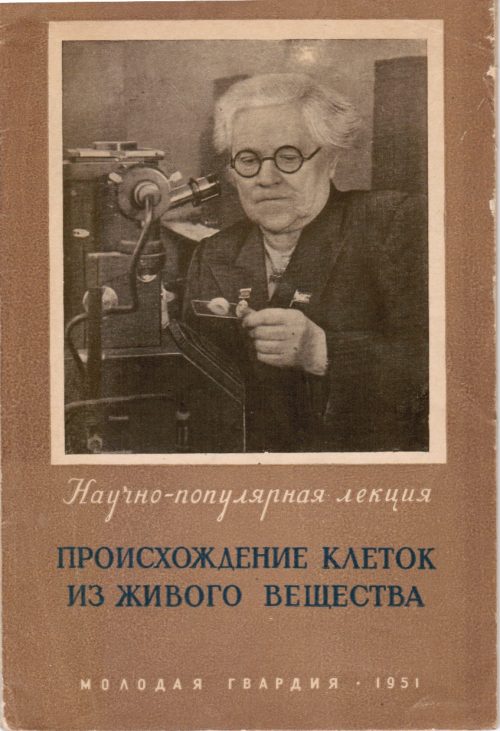 Title: О. Б. ЛЕПЕШИНСКАЯ, | действительный член Академии медицинских наук, | лауреат Сталинской премии. | Происхождение клеток | из живого вещества | [blank] | ИЗДАТЕЛЬСТВО ЦК ВЛКСМ | "МОЛОДАЯ ГВАРДИЯ" | 1951 || Pagination: original pictorial wrappers with portrait in frame, [1-2] – t.p. / imprint., 3-37 [38] [2] – blank / colophon.
Title: О. Б. ЛЕПЕШИНСКАЯ, | действительный член Академии медицинских наук, | лауреат Сталинской премии. | Происхождение клеток | из живого вещества | [blank] | ИЗДАТЕЛЬСТВО ЦК ВЛКСМ | "МОЛОДАЯ ГВАРДИЯ" | 1951 || Pagination: original pictorial wrappers with portrait in frame, [1-2] – t.p. / imprint., 3-37 [38] [2] – blank / colophon. -
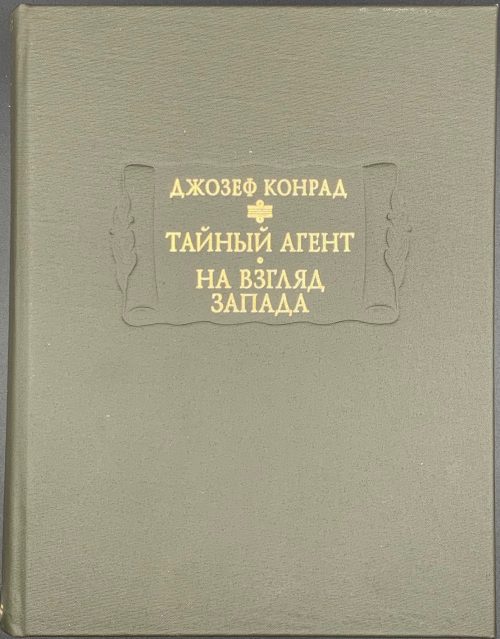 Title: ДЖОЗЕФ КОНРАД |{device} | ТАЙНЫЙ АГЕНТ | • | НА ВЗГЛЯД ЗАПАДА | • | Издание подготовил | В.М. ТОЛМАЧЕВ | Научно-издательский центр | «Ладомир» | «Наука» | Москва || Frontispiece: JOSEPH CONRAD |{device} | THE SECRET AGENT | • | UNDER WESTERN EYES || Pagination: [1-9] 10-595 [3] [2 advert.]. Binding: serial green cloth blind-stamped with a scroll adorned with gold lettering to board and spine, 22.5 x 17 cm. Original titles: [LIB-2762.2021] Joseph Conrad. The secret agent: a simple tale. — London: Methuen & Co., [1907]; [LIB-3213.2023] Joseph Conrad. The secret agent: A drama in three acts. — London, T. Werner Laurie, 1923.
Title: ДЖОЗЕФ КОНРАД |{device} | ТАЙНЫЙ АГЕНТ | • | НА ВЗГЛЯД ЗАПАДА | • | Издание подготовил | В.М. ТОЛМАЧЕВ | Научно-издательский центр | «Ладомир» | «Наука» | Москва || Frontispiece: JOSEPH CONRAD |{device} | THE SECRET AGENT | • | UNDER WESTERN EYES || Pagination: [1-9] 10-595 [3] [2 advert.]. Binding: serial green cloth blind-stamped with a scroll adorned with gold lettering to board and spine, 22.5 x 17 cm. Original titles: [LIB-2762.2021] Joseph Conrad. The secret agent: a simple tale. — London: Methuen & Co., [1907]; [LIB-3213.2023] Joseph Conrad. The secret agent: A drama in three acts. — London, T. Werner Laurie, 1923.


